Autumn cats: Conehead cat and Smokey (Part two)
Sunday, October 12, 2008
This is a continuation of Autumn cats: Part one.
 This autumn, in addition to transporting furniture and boxes of crap we’ve accumulated into our new house, we’re contemplating moving two or three stray cats with us. These planned acts of kindness clearly put us on the road to becoming crazy cat people. Read part one for more details on that.
This autumn, in addition to transporting furniture and boxes of crap we’ve accumulated into our new house, we’re contemplating moving two or three stray cats with us. These planned acts of kindness clearly put us on the road to becoming crazy cat people. Read part one for more details on that.
We already have two indoor cats, Lily and Eli. Lily the kitten was added to the family this spring after Smokey succumbed to illness. This post is about the amusing aftermath of Lily’s recent surgery and some more information about the late great Smokey.
Conehead Lily
Six-month-old Lily was spayed a couple of weeks ago. She also had her extra 23rd(!) claw removed at the same time. Now she’s down to an even 22 claws. She’s still a polydactyl freak, but at least her paws are symmetric. In addition to having her belly closed up with skin glue, the claw surgery required three stitches, which meant she had to wear a protective Elizabethan collar around her neck for almost two weeks. Hilarity ensued. Below are some photos of conehead (or, alternatively, buckethead) Lily. We had to find a tiny 8cm collar just to get the E-collar (cone) to stay on.

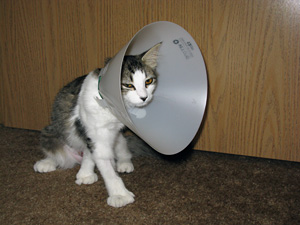
Because Lily initially struggled so much with the oversized cone, we attempted to make a more comfortable protective costume for her, using two tiny shirts meant for toy-sized dogs (AKA “punting dogs”) and a hand-sewn felt arm sleeve, all safety-pinned together. It was fun to attempt, but no matter how tightly we adjusted the outfit, Lily somehow managed to wriggle/pull her way out of it within a few hours. But how? It was like a kitten onesie!
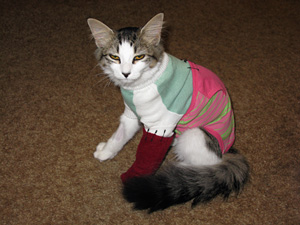
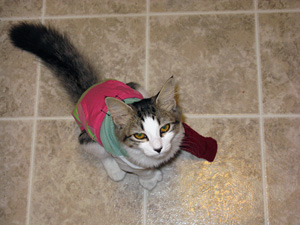
I know what you may be thinking, but no, under normal circumstances, we would never dress a cat in tiny clothes and make her participate in itty bitty kitty tea parties complete with little party hats and “special” catnip cakes. That would never happen. We were just trying to keep her from tearing up her healing paw and belly. Srsly.
Being too clever an escape artist for her own good, Lily was stuck with the clinic collar around her neck for most of the two weeks so she wouldn’t rip the stitches out. She was not a happy conehead.
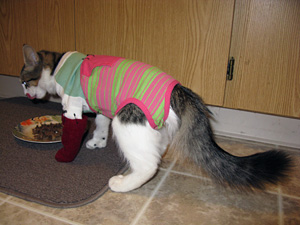

Over the past two weeks, there were so many fantastic opportunities to create lolcat FAIL photos, particularly when Lily tried to eat while wearing the E-collar . . . or when she tried to slink between two narrowly placed objects, an ajar door, or anything, really. It was pathetically funny.
Revisiting Smokey the housecat
Thank you to everyone who has written in over the past year about our cat Smokey. My November 2007 post, “Smokey the $1000 housecat: A Hemobart story,” is definitely the most-responded to post I’ve written for this blog. To fill everyone in: Unfortunately, a few months later, I had to follow up with more somber news. My May 2008 post, “Cats and ducklings: Part one,” reads: “our seven-year-old cat Smokey died on April 6 after a relapse of whatever had been ailing him last October (an autoimmune disorder and/or cancer). This time the steroids, antibiotics, and vitamin supplements didn’t work.”
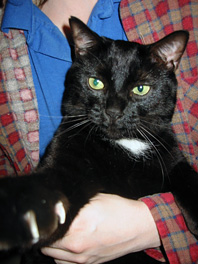 I will share some additional information for individuals with cats who might be suffering with similar symptoms. If you’re interested, you should read “Smokey the $1000 housecat: A Hemobart story” first.
I will share some additional information for individuals with cats who might be suffering with similar symptoms. If you’re interested, you should read “Smokey the $1000 housecat: A Hemobart story” first.
More about Hemobart: It is hard to tell whether a cat really has feline infectious anemia (AKA Hemobart) since the organism cannot be cultured in the lab. It’s essentially a hit-or-miss diagnosis. In Smokey’s case, his body was systematically killing off his red blood cells, which left him extremely lethargic and severely anemic. I am under the impression that this is what happens in actual FIA cases. The Hemobart organism attaches itself to the host’s red blood cells, thereby telling the body they are irregular and need to be eliminated. As far as other symptoms, Smokey vomited a few times, but not a lot because he slowly stopped eating. He was also dehydrated from not wanting to drink water.
More about Smokey’s prognosis: We ultimately determined that Smokey probably did not have FIA since he relapsed five months later, even after all the antibiotics and vitamins administered prior to, during, and following the blood transfusion. However, the blood transfusion did work very well (and we continued treating him with vitamins and a low dosage of prednisone). It appeared to cure him and he acted healthy again. His quality of life seemed to go back to normal, until the next relapse of whatever it was he had. I now believe it was most likely a cancer that affects the blood or bone marrow.
More about blood transfusions: If you believe your cat has FIA, or any other similar red blood cell problem, it cannot hurt to try to do a blood transfusion. It can be an expensive procedure, but it will help your cat regain his/her energy and appetite. The only drawback to doing the transfusion (beside the potential costs) is that if you have to do it a second time, the donor cat has to be screened for a matching blood type. This is because the receiving cat can build up antibodies to donated blood of a different type after the first transfusion. As you can imagine, this makes it difficult to have a transfusion done a second time. But hopefully you won’t need to do it more than once; if you do, that could be a sign your cat is too seriously sick for long-term recovery anyway.
Best wishes to all.